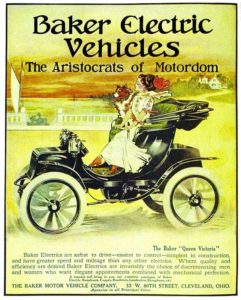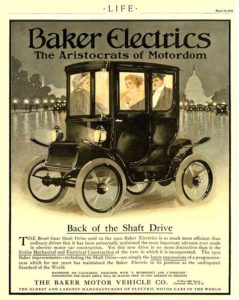Small Home Gazette, Winter 2017
Letter From the Editor: battery-powered cars
In their day, American bungalows were the apex of modernity.
They boasted forward-looking features—compact rooms with most of the living space on one floor; built-in storage; and (for the time) plenty of electrical outlets to power the latest vacuums, kitchen appliances and clothes washers.
Can you guess what other electric appliance bungalows might have powered?
Battery-powered cars.

 Baker Motor Vehicle Company was an American manufacturer of electric automobiles in Cleveland, Ohio, from 1899 to 1914.
Baker Motor Vehicle Company was an American manufacturer of electric automobiles in Cleveland, Ohio, from 1899 to 1914.
Yep, it’s true—Elon Musk and Tesla did not invent the electric vehicle. In the United States the first one was built around 1890 by a guy in Des Moines, Iowa. Astonishingly, by 1900 fully one-third of the automobiles in the U.S. were electric, according to the U.S. Department of Energy. Battery-powered cars had multiple advantages. They were quiet, didn’t emit nasty fumes and were far easier to start than cranking a gasoline engine to life. There was even a fleet of 60 electric taxis in New York City.
Electric cars’ popularity hummed along until Henry Ford’s Model T was introduced in 1908. They were much cheaper than electric cars, and their gas range far exceeded electrics’ battery capacity. By 1935, the electric car concept had gone into deep hibernation.
Now, 90 years after my bungalow was built, the electric car has returned. It’s questionable that my bungalow’s builder would have had one in 1926, but I suppose it’s possible. My garage, which is original to the house, was built to hold two cars. Did they have a battery model for zipping around town and gas version for road trips? Perhaps.
When you think of it, it’s amazing that our bungalows work as well as they do despite decades of technological advances. When I purchased a new car last fall, I didn’t hesitate to opt for a battery-powered Chevy Volt. The car is designed to run on battery for about 50 miles before switching to gas/electric hybrid mode, which means it needs to be plugged in overnight to charge.
Not a problem for my modern, electrified bungalow! I drove the car home from the dealership, pulled into my garage, unfurled its power cable, and plugged it in—just as early bungalow owners might have.
Except that it wouldn’t charge. A warning light indicated that the outlet wasn’t grounded; therefore, charging was a non-starter.
The following week, an electrician quickly remedied the situation. I had originally planned to install a 220-volt charger in my garage so that my car’s battery would reach full capacity in just 4.5 hours. But the electrician informed me that such an upgrade would involve digging a 2-foot-deep trench across my yard to lay high-capacity wiring from the house to the garage. The estimated cost: $2,800 to $3,000. I decided to make-do with the current 110-volt service, which charges my car’s battery in about 13 hours. Good enough.
Fortunately, our bungalows are able to adapt as technology advances. They have good bones; they’re not too large or too complicated; and it’s relatively simple (if not inexpensive) to replace a furnace, add air conditioning, or upgrade the electrical system as necessary.
But heed my experience: Check out your bungalow’s capacities before you bring home the latest shiny gadget.











